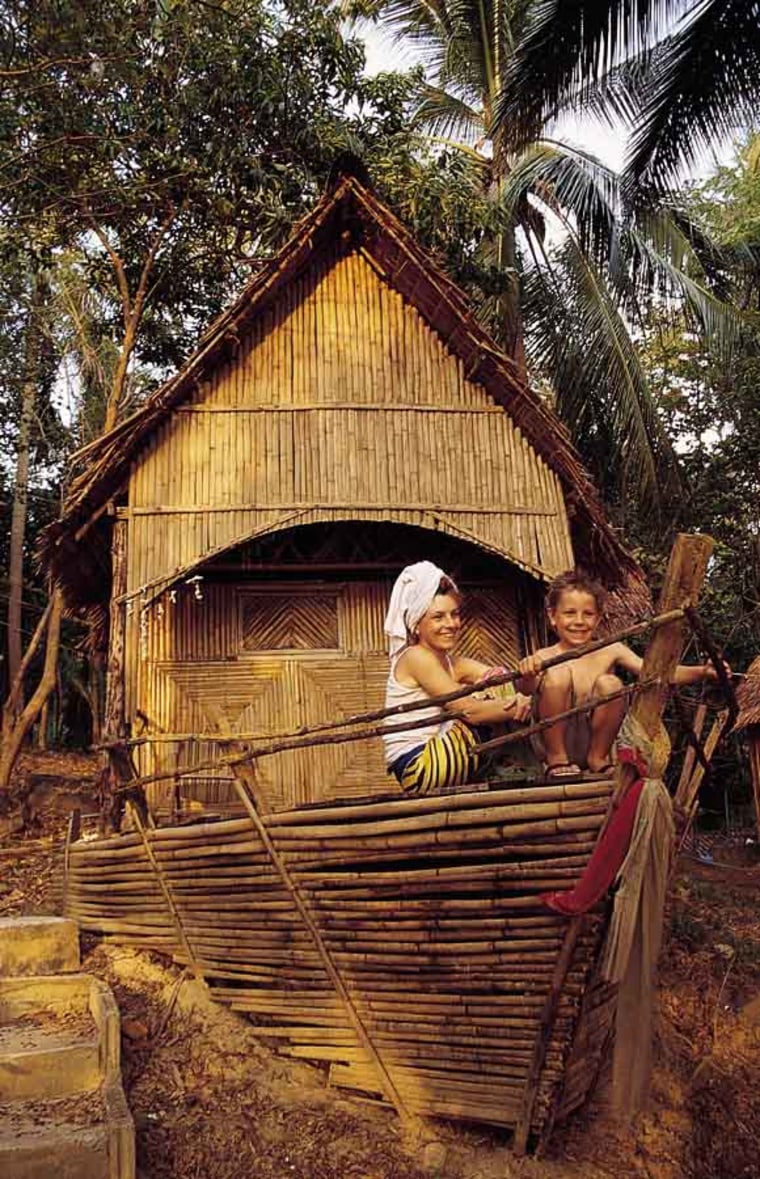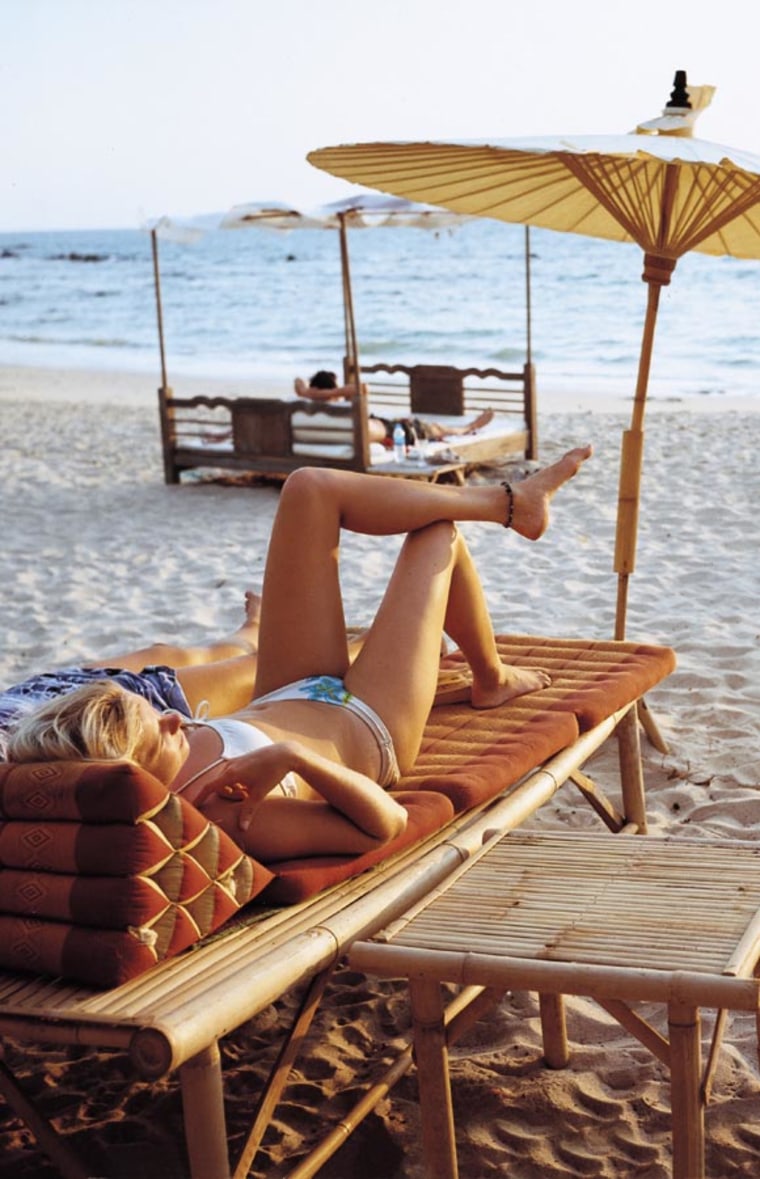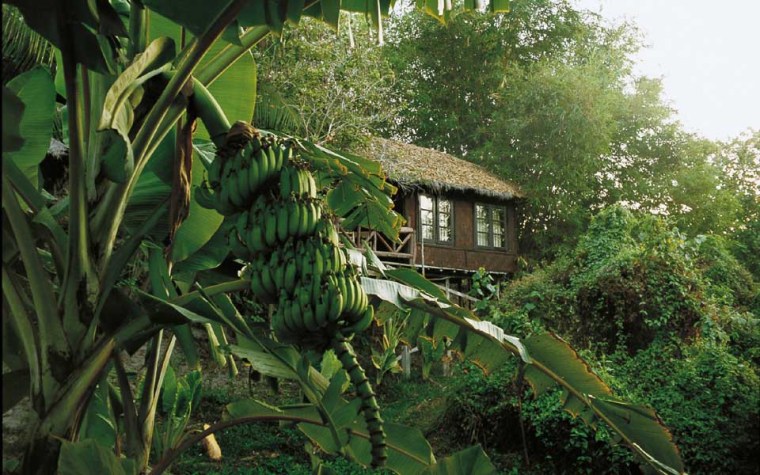Maybe you’ve seen pictures of southern Thailand’s sugar-sand beaches with grass-roof huts snuggled into the shade of coconut palms. Or you’ve heard of the ridiculously cheap prices: beachside bungalows for $10 a night, spicy meals for $3. Or you’ve dreamed of discovering some hidden lagoon that lies beyond the reach of guidebooks, just as the characters did in Alex Garland’s cult novel The Beach (which, like the Leo DiCaprio film based on the book, was set here).
The problem is that if you’ve seen, heard, or read about a place, chances are others have too. And, as Garland’s characters learn, anywhere hailed as a paradise on earth has to fall short of expectations. The tourism industry has taken its toll on some of Thailand’s islands: claptrap towns, ubiquitous 7-Elevens, longtail-boat touts haranguing passersby, and bungalow operations and hotels elbowing for room on crowded beachfronts. Phuket is the most obvious example—once the darling of Hippie Trail backpackers in the ’70s, the famous beach resort has been ruined, in some travelers’ eyes, with big tourist crowds and cement poured over far too much of the island.
But charm, serenity, and beauty still cling to several of southern Thailand’s other isles, or ko, and we’ve rounded up the best of the bunch.
The Gateway Ko Samui
Don’t let the single runway and the open-sided thatched-roof terminal at Ko Samui’s airport fool you. Samui is the largest island on the Gulf of Thailand side of the Malay Peninsula. It’s so big that it doesn’t really feel like an island. Instead, Samui often serves as a springboard to the solitude found only on smaller isles. Still, there are loads of fabulous beaches, with dozens of hotels lining the shoreline. You probably don’t want to spend a full week on Samui, but it’s worth taking a day or two there to get over jet lag before heading onward.
One reason to hang around is the $45 all-day boat tour through Ang Thong Marine Park, a collection of 41 largely uninhabited islands between Samui and the mainland. While on the tour, you can kayak to shore, hike to a waterfall, and snorkel in sheltered coves. Several companies offer slightly different versions of this popular tour, but they all include a short clamber up to the top of Ko Mae Ko to see the pristine, fully enclosed lagoon hidden at its center, a spot that helped inspire the plot of The Beach (if you’re unfamiliar with the book and film, don’t worry—you’ll hear about them plenty while you’re here). Sea Safari Thailand is one of the least expensive operations and throws in a hokey 20-minute elephant ride at the end of the tour.
Chaweng Beach has both the best strip of sand on Samui—a wide swath of soft, pale yellow that extends for nearly four miles—and the most choices for lodging and dining. Somewhere between the pricey resorts on the north end of Chaweng and the $3 backpacker hovels at the beach’s center lies The Island resort. Its layout is pretty typical for Samui: tidy cottages on either side of a shady cement walkway that’s a short stroll from the shops and travel agents on the dusty main road. Call ahead to snag thatched cabin 801, where you can step off your front porch right onto the sand.
The food at The Island is scrumptious, and in the evening tables are moved out onto the sand so guests can dine by candlelight. Also, try Budsaba, a romantic collection of thatched wooden huts called salas on the grassy grounds of the Muang Kulaypan Hotel. Each hut is barely large enough to fit a table and four people reclining on cushions. Dinner costs only about $16 per person, and live traditional Thai music plays as cool sea breezes tickle your toes (as per local custom, shoes come off before you sit at the table).
The Scene Ko Phi Phi
Heralded as one of the most idyllic spots on earth, tiny Phi Phi Don consists of two mountains connected by a narrow beach that’s home to a lively tourist town. It’s here that happy, sun-crisped couples and crowds of backpackers throng the narrow lanes, popping into Internet cafés, bargaining for cheap silk sarongs, and arranging diving trips at travel agencies. There are a few soulless, low-rise hotels in Phi Phi, but that doesn’t spoil the funky, welcoming, homegrown feel of its thriving village.

Sadly, neither of Phi Phi’s main beaches is ideal for swimming. Southerly Ton Sai bustles with ferries, speedboats, and longtails hogging up the prime shoreline. Northerly Lo Dalum beach is quiet and lovely but consists mainly of mudflats, which are under water that’s knee-deep several hundred feet out to sea. For great swimming and snorkeling, many tourists hire boats to take them to one of the many isolated coves around the mountainous sides of Phi Phi.
The most popular boat ride is a $7 half-day trip of sun and snorkeling at Phi Phi Don’s uninhabited sister island, Phi Phi Leh. Book the outing at the front desk of your hotel or through any of the tour operators in town. One of Leh’s protected coves was used to film—what else?—The Beach, but for decades its claim to fame was Viking Cave. This huge cavern is where chao ley (Muslim “sea gypsies”) scramble hundreds of feet up bamboo and vine ladders to scrape sea-swallow nests off the rocks. Restaurants in Hong Kong, Taiwan, and Singapore pay upwards of $20 for each cup-size mass of bird spit and twigs, which are used to make the delicacy known as bird’s nest soup. The chao ley wisely harvest only the first two nests a bird builds, then they leave the swallow alone to build a third so this gravy train can continue into the next generation.
Resorts on the mountainous sides of Phi Phi Don tend to be lavishly upscale. An affordable alternative is in a tiny cove just east of the main beach and three minutes from town by longtail boat. The quirky resort called Maprao features bungalows fashioned from sticks to resemble little boats, with each porch/prow pointing out to sea. The bungalows dot a hilly jungle area above a restaurant with tables under the shade of palm trees. If you prefer more action, stay in town at the PP Charlie Beach Resort, where the bungalows are packed in tightly, but each unit has a tidy plot of greenery in front.
Noodle shacks selling decent enough curries and pad Thai abound in town. Most restaurants that serve international cuisine are overpriced, but one exception is Le Grand Bleu, a classy restaurant with French-inflected Thai food in an old northern Thai–style wooden building, just a few steps from the ferry docks.
There’s a lot of low-key partying on Phi Phi. A jovial crowd knocks back Singha beers at Reggae Bar, which has a big screen playing rock videos and a kickboxing ring for nightly matches. For a more peaceful evening, drink fruity cocktails at Jungle Bar, an ersatz Tarzan-in-the-Tropics, open-air joint with a sandy floor, tiki torches, and cups made from bamboo.
The Party Ko Phangan
Phangan, a short ferry ride north of Samui, might be the only destination where high season comes once a month. The local tourist calendar is tied to a lunar cycle that peaks during the Full Moon Party, an all-night rave fueled by cheap booze and designer drugs with thousands of people dancing on the sand of Hat Rin Nok (Sunrise Beach).
In the interval between parties, the entire island seems subdued and hungover, with shuttered beachfront bars, deserted cybercafés, and largely empty clusters of bungalows. If you aren’t up for the 20-something rave scene, anytime other than during the full moon is when you want to visit Phangan. It almost feels like you have the island to yourself before and after each monthly bash, the only hints of which are empty bottles littering the beach. But soon enough, a few days before the moon waxes full again, the next batch of partyers arrives, fails to find a room, camps out on the beach, and the fun begins all over again.
The operation that started it all, Paradise Bungalows, is Full Moon Party central. Its bungalows, though utterly basic, are picturesque, climbing up the hillside or right on the beach under the shade of coconut palms. Standing head and shoulders above the Paradise Bungalows—literally and figuratively, as they’re propped up on stilts—are the spacious cottages of Sun Cliff, well removed from the hubbub of the town near Hat Rin Nai (Sunset Beach). While some cottages have air-conditioning, the favorite has to be fan-cooled bungalow D2, a fabulous Swiss Family Robinson-goes-to-Asia “tree house,” where the front end is 25 feet above the ground. The back wall is anchored to the rock of the steep cliff, and in a few spots the boulders intrude into the wood-ceiling bedroom. Even the bathroom has a tree growing up through the middle of the floor and out through the translucent corrugated-plastic roofing. French doors fold back to open two entire walls of the bedroom onto a wraparound balcony, and there’s a hammock overlooking the sea.
Sunrise Beach is connected to Sunset Beach by a road lined with Internet cafés, bakeries, noodle shops, and souvenir stands. The main intersection, inexplicably dubbed Chicken Corner, is the island’s commercial hub. You’ll find the best dinner on the island just down a side street from this crossroads at the Old Lamp, a backpacker joint where shoes come off at the door, everyone sits on the floor, and the portions of curries and rice are massive.
The Secret West Railay Beach, Krabi
West Railay Beach looks and feels like what many tourists expect of the Thai islands: craggy karst cliffs and gorgeous beaches, reachable by a 20-minute boat ride, and, to get onshore, a wade through the surf with your bags overhead. The irony is that Railay is not an island at all;

it’s on the mainland, near the river town of Krabi. But when a spot is this isolated and undeveloped, with only four bungalow operations carved out of the thick seaside jungle, who cares that it’s not surrounded by water?
Railay is carefree and casual. Resort staffs take over sections of the beach for pickup soccer matches around sunset. Although the concentrated cluster of bungalows brings longtail boats roaring in and out of the heart of the beach all day, it’s not too difficult to find a peaceful stretch of sand. From a position on the beach facing out to sea, turn right and walk a couple hundred feet to the end, then wade out around the little headland. The beach beyond is nearly abandoned.
There’s precious little difference between the four bungalow resorts at Railay; each consists of modern cottages lining a garden-like cement walkway running back from the beachfront. Railay Village Resort gets top marks if only because it tends to be the cheapest of the lot. The resorts are also the only games in town for meals (though there is a mini-mart/cybercafé where you can buy snacks). One drawback to Railay’s being so far out in the boondocks is that prices for everything from lodging to bottled water are double or triple what you find on the islands. Don’t let that discourage you from coming here. Even with the rates jacked up, things still seem inexpensive to most international travelers.
The Retreat Ko Lanta
A crowd of sign-waving Thai islanders standing three-deep greets ferries as they arrive in Lanta. It looks like a very confused protest rally, but each sign represents a different resort on the island. There’s no public transportation on Lanta, so any hotel with vacancies sends an envoy to collect as many tourists as he can cram into the back of a miniature pickup truck. This may seem chaotic, but it works with surprising efficiency. And it’s well worth putting up with to spend a few days on the most laid-back of the major ko.

The west coast of Lanta is lined with an almost continuous string of bungalow resorts. Even so, it doesn’t feel overdeveloped. The unbroken line of palm trees provides shade for wide, soft-sand beaches, and the single dirt access road that snakes down the island is sufficiently rutted and bumpy to give you the feeling you’re way out in the sticks.
Relax Bay is aptly named. Set back from a private beach amid lush gardens, the solid, wooden bungalows have fan-cooled rattan interiors, floors made of dark wooden slats, and colorful hammocks strung on every front porch. A bridge arches like a cat’s back over a stream flowing through the property. The dining area is open on all sides, and a breeze gently ruffles the curtains around the massage mats set near the beach. In addition to the wooden tables and chairs on the beach, there’s an old canopy bed out on the sand for lazing away the afternoon. Nightlife revolves around a campfire by the water.
Just a few hundred feet up the beach from Relax Bay is the cheaper, funkier Lanta Marina Resort, a hodgepodge of cottages and bungalows run by a friendly woman named Nita. Her best bungalows—arranged around a U-shaped boardwalk—are built with loosely stacked branches. The wide gaps between them fill the rooms with a luminous play of light shafts on the gauzy mosquito netting around the beds. Nita describes it as traditional Thai construction and a primitive form of air-conditioning.
There’s little to “do” on Lanta other than rest, sip fruity drinks, endure endless massages, and wander the beach admiring the swirling patterns left by miniature sand crabs.
What to know before you KO
Getting to the islands: There’s no need to book flights within Thailand ahead of time. Travel agencies litter the Bangkok backpacker enclave of Khao San Road and its parallel, Rambuttri, where you can pick up Bangkok Airways tickets—B.A. is cheaper and nicer than Thai Airways—to Samui ($90 one way) for the gulf islands or to Krabi or Phuket (each about $65 one way) for Railay, Phi Phi, and Lanta, on the Andaman Sea. Be ready to pay $2 to $10 in local currency for arrival and departure taxes at every airport. Buses and trains from Bangkok are cheaper but eat up at least 12 hours; plane trips are 90 minutes max.
Island-hopping: Navigating between the islands is easy. Ferries ply the waters between popular isles several times daily for $5 to $10, and travel agents display routes and departure times. Short hauls that lack ferries are served by longtail boats—speedy, huge canoes with oversize motors roaring at the back—for $1 to $4. Flights between Samui and Krabi cost under $50. To get around the larger islands, songthaews (pickups and vans that act as public buses), tuk-tuks (three-wheel taxis), or scooter taxis cost a few bucks on any run. If you book a hotel in advance, they’ll often pick you up at the airport or ferry dock.
Communicating: English is widely spoken, though starting conversations with a greeting of sawat-dee and ending with a khowp khun (thank you) is always appreciated.
Lodging: It may seem crowded—especially during high season, November through April—but don’t panic. With rare exceptions, supply exceeds demand, and you can almost always find a room. Calling ahead ensures a better selection, however, so if your heart is set on that beachside bungalow, book a few days in advance. Air-conditioned rooms cost more than fan-cooled ones, but many people actually prefer fan rooms with mosquito netting on the beds. It’s more relaxing when you can throw open the windows to tropical breezes and sounds of gentle surf rather than being in a sterile, musty room with A/C.
